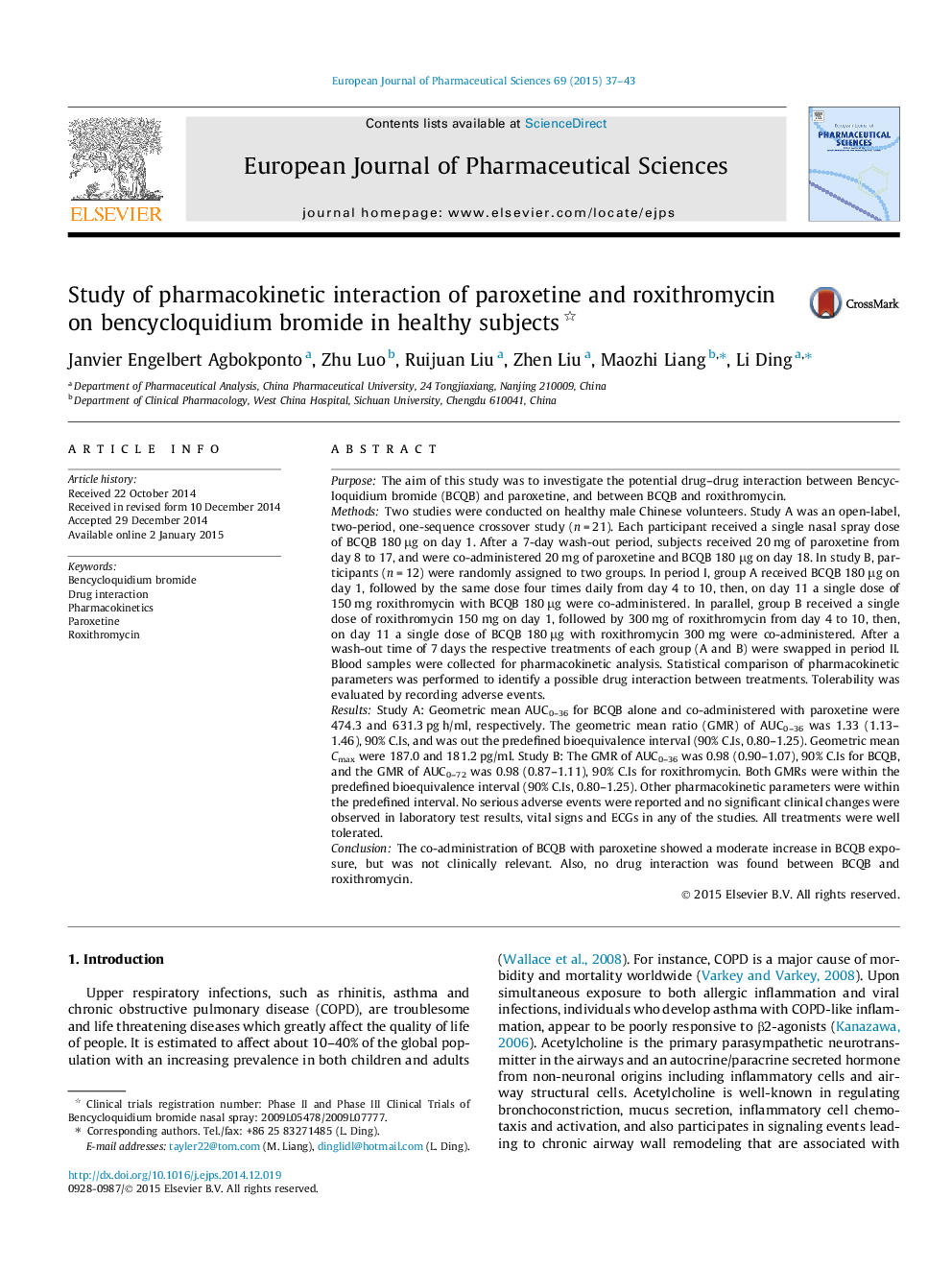| کد مقاله | کد نشریه | سال انتشار | مقاله انگلیسی | نسخه تمام متن |
|---|---|---|---|---|
| 2480367 | 1556181 | 2015 | 7 صفحه PDF | دانلود رایگان |

PurposeThe aim of this study was to investigate the potential drug–drug interaction between Bencycloquidium bromide (BCQB) and paroxetine, and between BCQB and roxithromycin.MethodsTwo studies were conducted on healthy male Chinese volunteers. Study A was an open-label, two-period, one-sequence crossover study (n = 21). Each participant received a single nasal spray dose of BCQB 180 μg on day 1. After a 7-day wash-out period, subjects received 20 mg of paroxetine from day 8 to 17, and were co-administered 20 mg of paroxetine and BCQB 180 μg on day 18. In study B, participants (n = 12) were randomly assigned to two groups. In period I, group A received BCQB 180 μg on day 1, followed by the same dose four times daily from day 4 to 10, then, on day 11 a single dose of 150 mg roxithromycin with BCQB 180 μg were co-administered. In parallel, group B received a single dose of roxithromycin 150 mg on day 1, followed by 300 mg of roxithromycin from day 4 to 10, then, on day 11 a single dose of BCQB 180 μg with roxithromycin 300 mg were co-administered. After a wash-out time of 7 days the respective treatments of each group (A and B) were swapped in period II. Blood samples were collected for pharmacokinetic analysis. Statistical comparison of pharmacokinetic parameters was performed to identify a possible drug interaction between treatments. Tolerability was evaluated by recording adverse events.ResultsStudy A: Geometric mean AUC0–36 for BCQB alone and co-administered with paroxetine were 474.3 and 631.3 pg h/ml, respectively. The geometric mean ratio (GMR) of AUC0–36 was 1.33 (1.13–1.46), 90% C.Is, and was out the predefined bioequivalence interval (90% C.Is, 0.80–1.25). Geometric mean Cmax were 187.0 and 181.2 pg/ml. Study B: The GMR of AUC0–36 was 0.98 (0.90–1.07), 90% C.Is for BCQB, and the GMR of AUC0–72 was 0.98 (0.87–1.11), 90% C.Is for roxithromycin. Both GMRs were within the predefined bioequivalence interval (90% C.Is, 0.80–1.25). Other pharmacokinetic parameters were within the predefined interval. No serious adverse events were reported and no significant clinical changes were observed in laboratory test results, vital signs and ECGs in any of the studies. All treatments were well tolerated.ConclusionThe co-administration of BCQB with paroxetine showed a moderate increase in BCQB exposure, but was not clinically relevant. Also, no drug interaction was found between BCQB and roxithromycin.
Figure optionsDownload high-quality image (128 K)Download as PowerPoint slide
Journal: European Journal of Pharmaceutical Sciences - Volume 69, 10 March 2015, Pages 37–43